
views
The frustration of delayed justice was well captured by actor Sunny Deol in the 1993 movie ‘Damini’ as he angrily shouted ‘tarikh par tarikh’ (dates after dates) in a courtroom. Interestingly, even today the situation shown in the film fits for about 2,200 cases that are pending across high courts and lower courts for more than 50 years now, data analysed by News18 shows.
In the just concluded monsoon session, the Centre has proposed the Bharatiya Nagrik Suraksha Sanhita, 2023, which seeks to replace the Code of Criminal Procedure (CrPC), 1973. With the proposed law, the government is aiming to transform the judicial picture and speed up investigation and trial.
With the new law, there will be a deadline for filing of a charge sheet (90 days); framing of charges (60 days), and delivery of judgment (30 days) after the conclusion of the hearing.
While the law is awaited, here is a look at the pendency at the Supreme Court, the high courts and subordinate courts.
A Better Picture in Supreme Court
The last 10 years’ data on pendency in the Supreme Court, seen by News18, shows 50,000 to 70,000 cases. As of August 1, the number was 69,243. Out of the total pending cases, 49,994 are admission matters while the rest are matters of regular hearings.

While there are no details of the years since when the cases are pending, further digging into numbers shows that as of July at least 29 cases are pending for adjudication before the Supreme Court in the form of Constitution Bench cases.
Out of these 29 cases, 18 cases are pending before the five-judge bench, six cases before seven-judge bench and five before nine-judge bench for adjudication. At least three cases out of the total 29 are from the 1990s.
The five cases pending before the nine-judge bench were filed between 1999 and 2006. Further, the four out of the six cases pending before the seven-judge bench were more than 10 years old with the earliest case from 1994.
Seven out of the 18 cases pending before the five-judge bench are more than 10 years old with the earliest one are from 1992 and 1996.
Constitution Benches of the Supreme Court are for matters related to cases involving a substantial question of law as to the interpretation of the Constitution. These are usually assembled in five, seven or nine-judge benches.
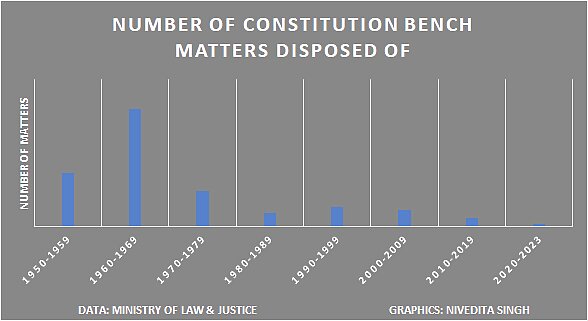
According to the law ministry, in respect of the Constitution Bench cases, there are intricate issues of law involved and arguments are addressed for a number of days ranging from weeks to months. These issues require deep analysis and thorough examination of law. The ministry also said it is not possible to set out strict parametres and timelines regarding adjudication of such cases.
When compared to the lower and high courts, the situation is much better at the apex court level.
Oldest pending cases in HC dates back to 1952
As of today, at least 60.54 lakh cases are pending before the high courts across India. At least 1,063 of these cases are pending for more than 50 years.
The oldest cases in the high courts date back to 1952 – two from Calcutta and one from Madras. The numbers further show that out of the total pending cases in HCs, 90 are from 1952-62 and 957 are from 1962-72.
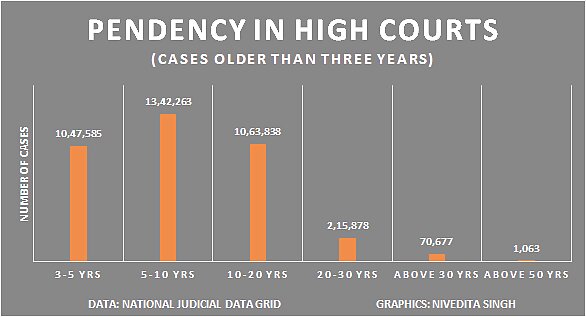
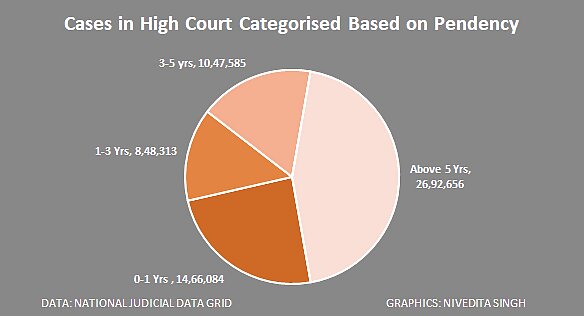
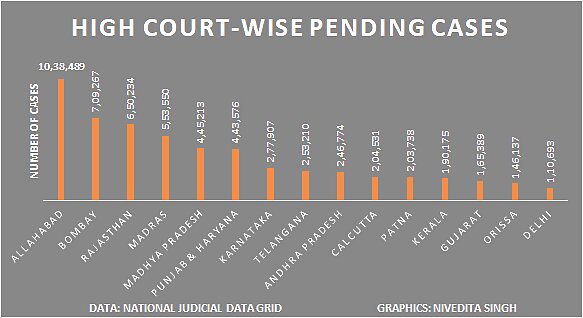
Out of the 25 high courts in India, in at least 15, the pendency is of more than one lakh with Uttar Pradesh topping the chart at 10.38 lakh followed by Bombay at 7.09 lakh pending cases.
Among the total pending cases, at least 6.36 lakh were filed by senior citizens, including 1.54 lakh criminal cases. Further, 3.86 lakh cases were filed by women including 81,300 criminal cases.
District and Subordinate Courts most burdened
The highest pendency of cases is in District and Taluka Courts across the country. With more than 4.45 crore cases pending, the lower courts in India are in the worst situation and, out of these, 1,150 cases are more than 50 years old, including 350 criminal cases.
Out of the 4.45 crore cases pending in these courts, more than 1.88 crore are pending for more than three years and over one lakh cases are older than 30 years. Uttar Pradesh again tops the chart in pendency with more than one crore pending cases in lower courts.
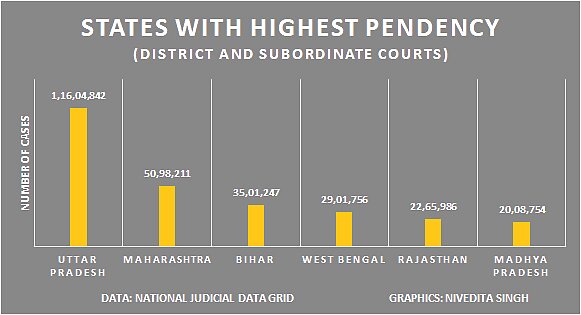

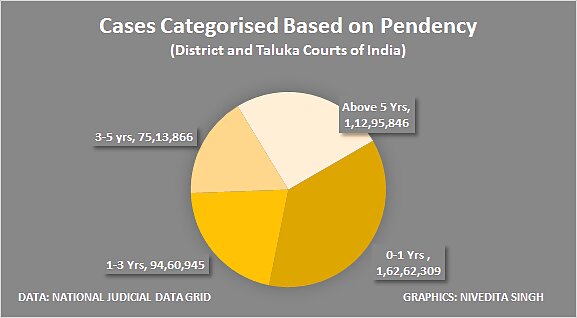
WHY HIGH PENDENCY?
There is no single reason for the delay in justice and results in pendency. Pendency of cases in courts can be attributed to several factors including non-availability of adequate number of judges and judicial officers, supporting court staff and physical infrastructure.
It is also impacted due to complexity of facts involved, nature of evidence, co-operation of stakeholders — bar, investigation agencies, witnesses and litigants and proper application of rules and procedures.
The other factors that lead to delay in disposal of cases include lack of prescribed time frame by respective courts for disposal of various kinds of cases, frequent adjournments and lack of adequate arrangement to monitor, track and bunch cases for hearing.
Further, the criminal justice system functions on assistance by various agencies including police, prosecution, forensic labs, and experts such as medico-legal. Delay in providing assistance by allied agencies also entails delay in disposal of cases.
While the Monsoon Session of Parliament has ended, the government now has only the winter session to bring in the new law for timely justice before the 2024 Lok Sabha polls.




















Comments
0 comment